Many technical writers struggle with time management. Deadlines are always tight, and there’s no room for error, so writers always need to keep their heads down and their concentration up.
All of this can put a lot of pressure on a person, so we’ve prepared a list of tips you can use to manage your time better without exposing yourself to more stress.
Read on and work smarter, not harder!
Establish a Schedule
The process of creating technical documentation isn’t as easy as just sitting down and writing.
Every document has to be researched, drafted, and pass multiple rounds of reviews, meaning excellent organizational and scheduling skills are pivotal for technical writers.
Unfortunately, most technical writers, much like all other knowledge workers, don’t have a time management system in place to bring order to their hectic schedules.
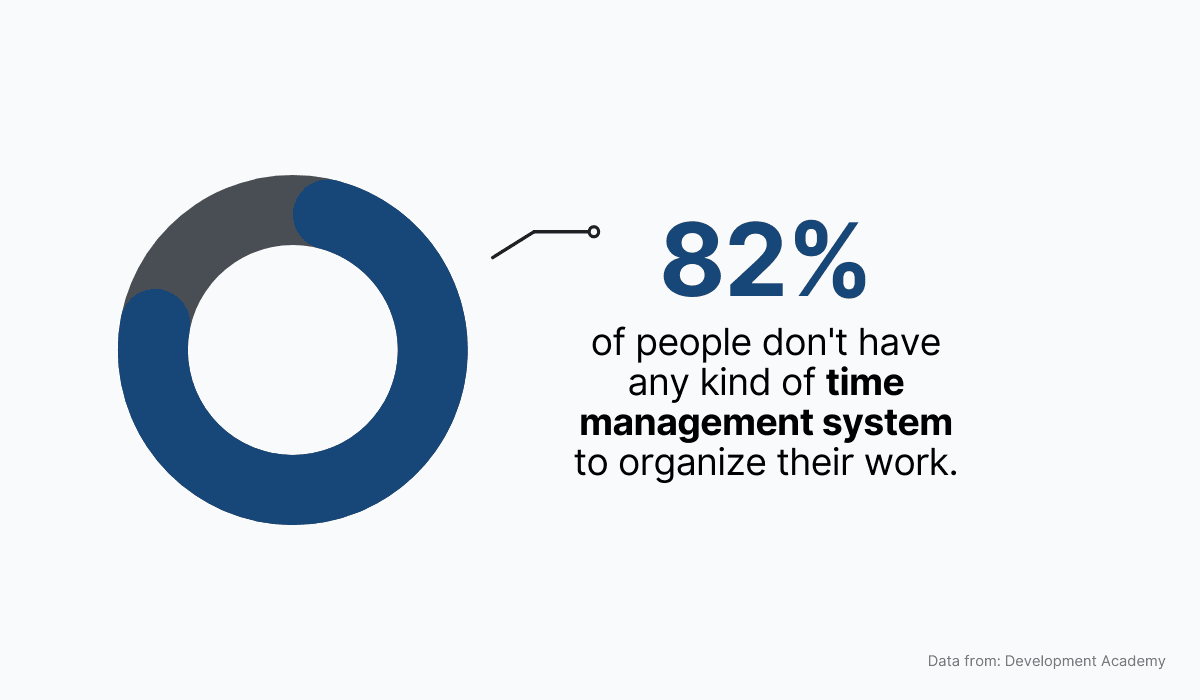
Source: Archbee
The methods they use to schedule their work often don’t go beyond hand-written lists and their email inbox.
That isn’t to say that there aren’t some excellent examples to follow in the industry.
One of them is Amruta Ranade, technical writing influencer and head of docs at Airbyte. Her work as a technical writer follows a schedule she developed after years of experience.
In the video below, she takes us through her daily routine. Let's analyze it and see if we can pick up some good practices.
Source: Amruta Ranade on YouTube
First of all, note that every week starts with planning. Current projects are divided by document phase, and then a schedule for the entire week is created in Google Calendar.
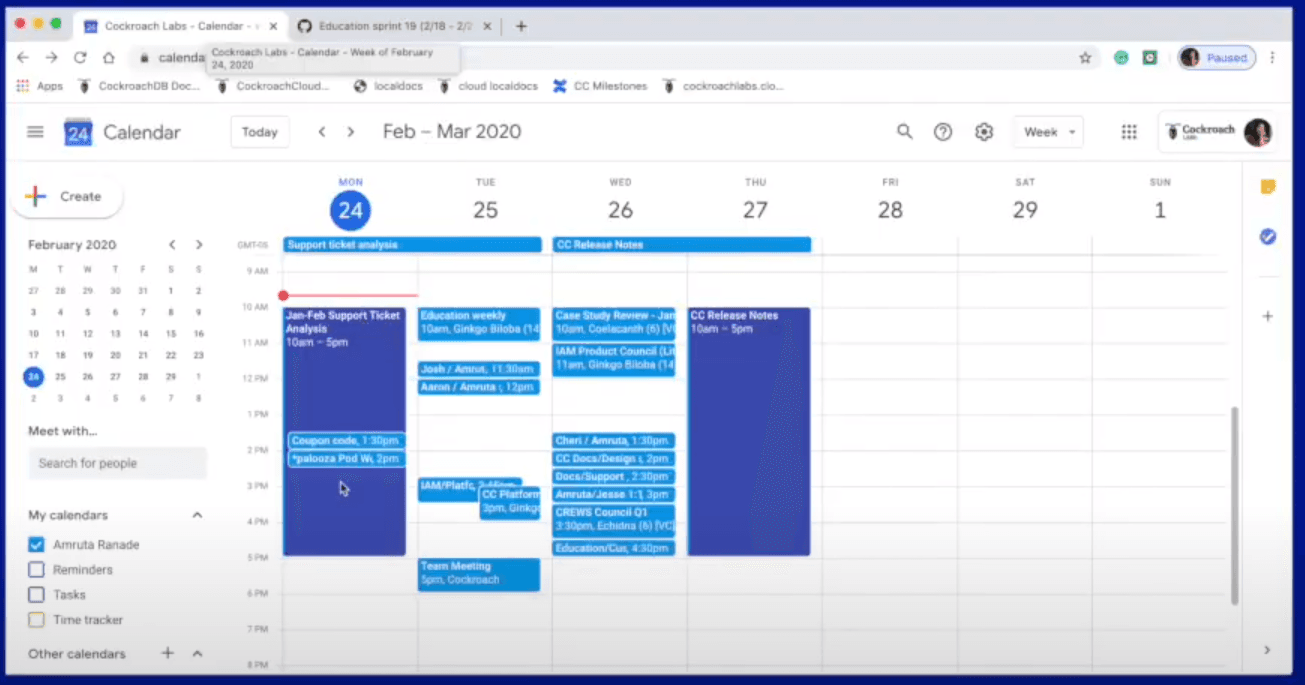
Source: Amruta Ranade on YouTube
This is a good way to start your week because it will give you an overview of your current projects, tell you which ones need to be prioritized and how to order the tasks that lie ahead.
The other great lesson to learn from Ranade is how conscious she is of her energy levels and ability to focus at different times of the day. As she says in the video:
“Morning is usually the most productive time for me, so I block off time in my calendar for heads-down writing. That’s when I do my user testing and drafting tasks.”
Afternoons, then, are reserved for meetings (including team meetings and one-on-ones with SMEs and her manager).
Finally, Ranade uses the breaks between meetings, when she doesn’t have enough time to concentrate, to do some “shallow work,” or in this case, reviews and editing for the documents in later stages of development.
As you can see from Amruta Ranade’s great example, establishing a work schedule doesn’t have to be hard.
Just take some time to plan and work out a routine that best suits you. These small steps should already have an enormous impact on your ability to successfully manage your time.
Create a To-Do List
To reiterate our previous point, the work of a technical writer consists of a variety of smaller tasks that push the document towards publication.
At any given time, you’ll have documentation in some (or all) of the following phases:
- Research
- SME collaboration
- Drafting
- Reviews
- Revisions
- Upload/publication
As you can imagine, work can get pretty chaotic if these tasks are not kept in check.
Luckily, there’s a simple method that can help you ensure you’re not dropping any of the tasks and that every document is completed on time, with very little idle time in between tasks.
We’re talking about the to-do list, of course.
Research shows that to-do lists are extremely helpful time management tools because they unburden our brains and reduce the anxiety we feel when we know we have a lot of work ahead of us.
With our minds unburdened, we can concentrate on getting things done, which shortens the time to task completion and reduces the probability of errors.
However, a word of caution is in order. To-do lists can sometimes backfire because, by adding a task to your list, you’re essentially postponing it for a later time.
In fact, studies have shown that almost half of the tasks from to-do lists never get completed.
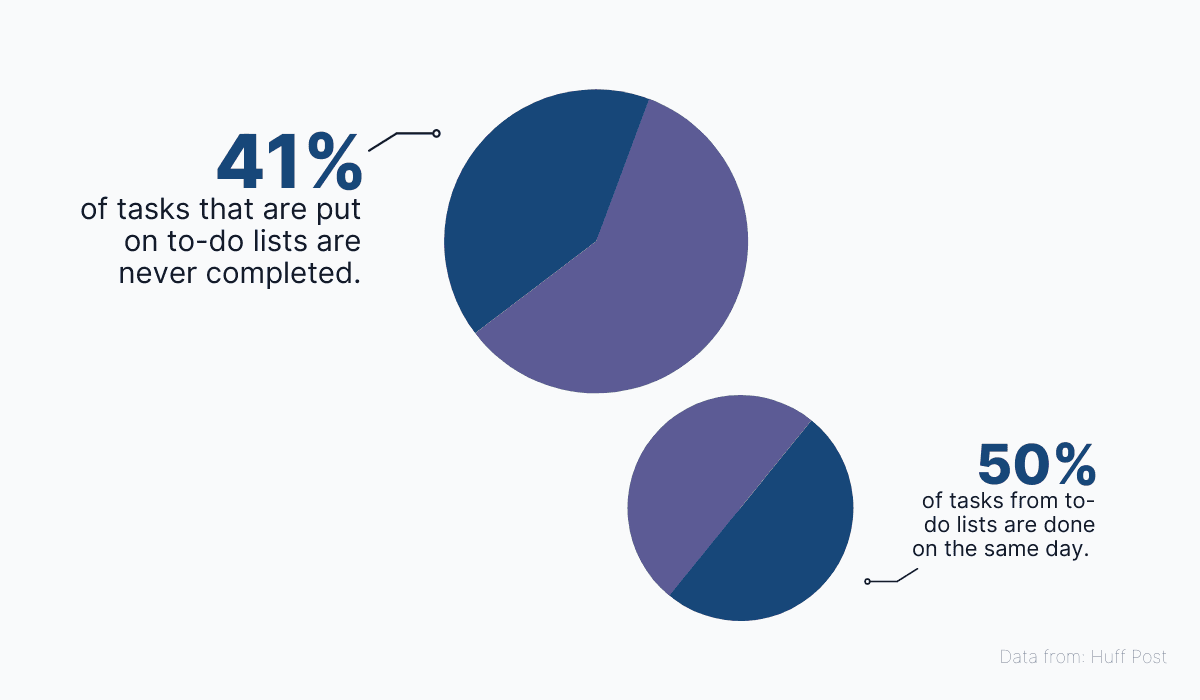
Source: Archbee
Another problem is that ordinary to-do lists don’t explicitly say how long a task will take or how important it is, meaning that tasks are not ordered in a way that will help you get as much as possible done.
E.J. Masicampo, a notable psychologist researching the efficiency of to-do lists, sums it up well:
“It is all too easy to treat the to-do list like a menu where you’re constantly ordering the easiest-to-swallow tasks while the more undesirable tasks fester and grow in number. This happens because to-do lists describe what we have to do without specifying when and how we need to do it.”
Therefore, using to-do lists for your technical writing tasks is definitely a good idea, but you should be smart about it and implement an efficient system.
For example, you could use a software tool.
There are many available, such as the popular Todoist, which enables you to quickly add items to your to-do list and order them according to priority.
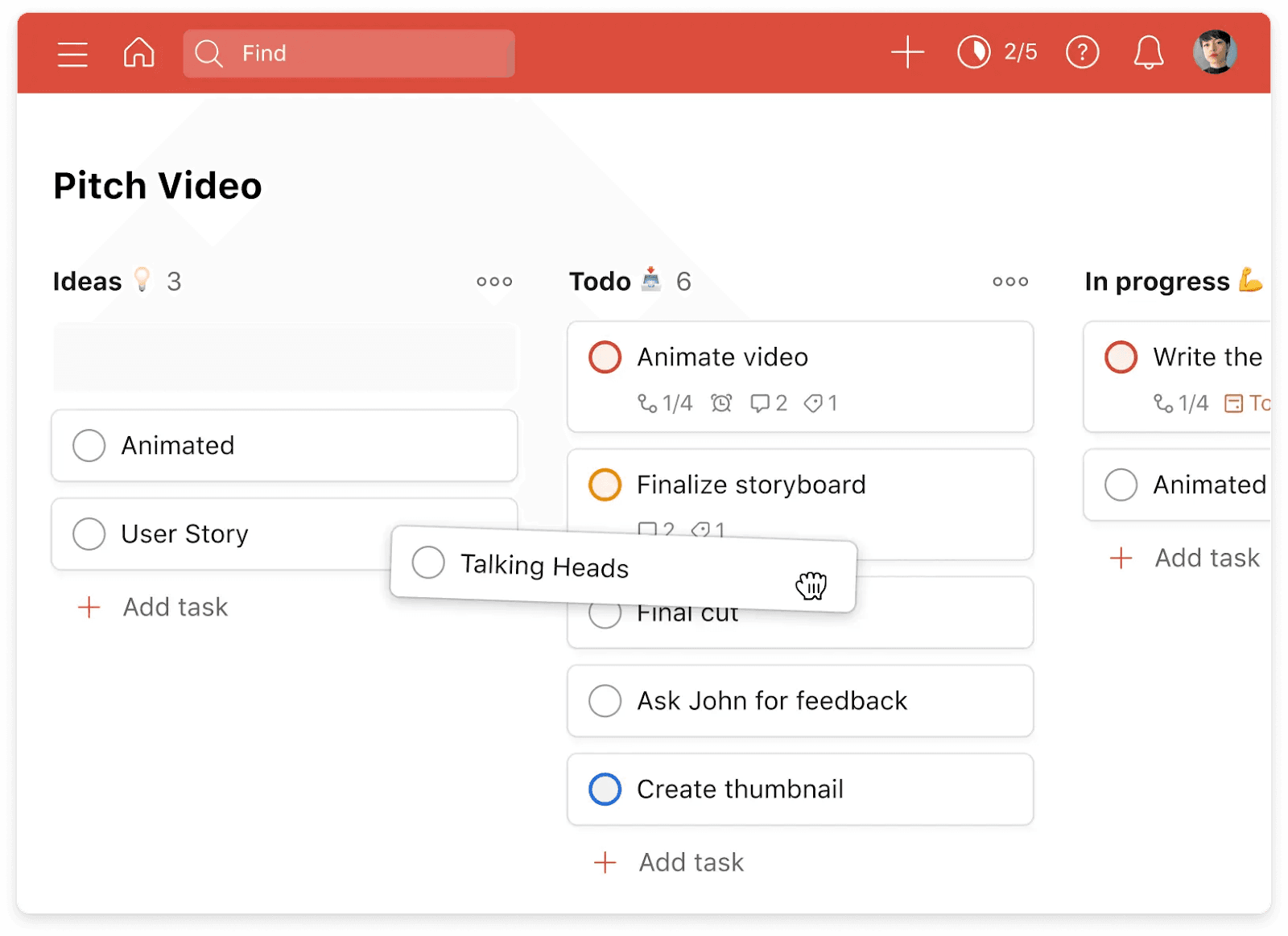
Source: Todoist
It also has features that let you keep track of your progress and set daily or weekly goals to motivate you and keep you productive.
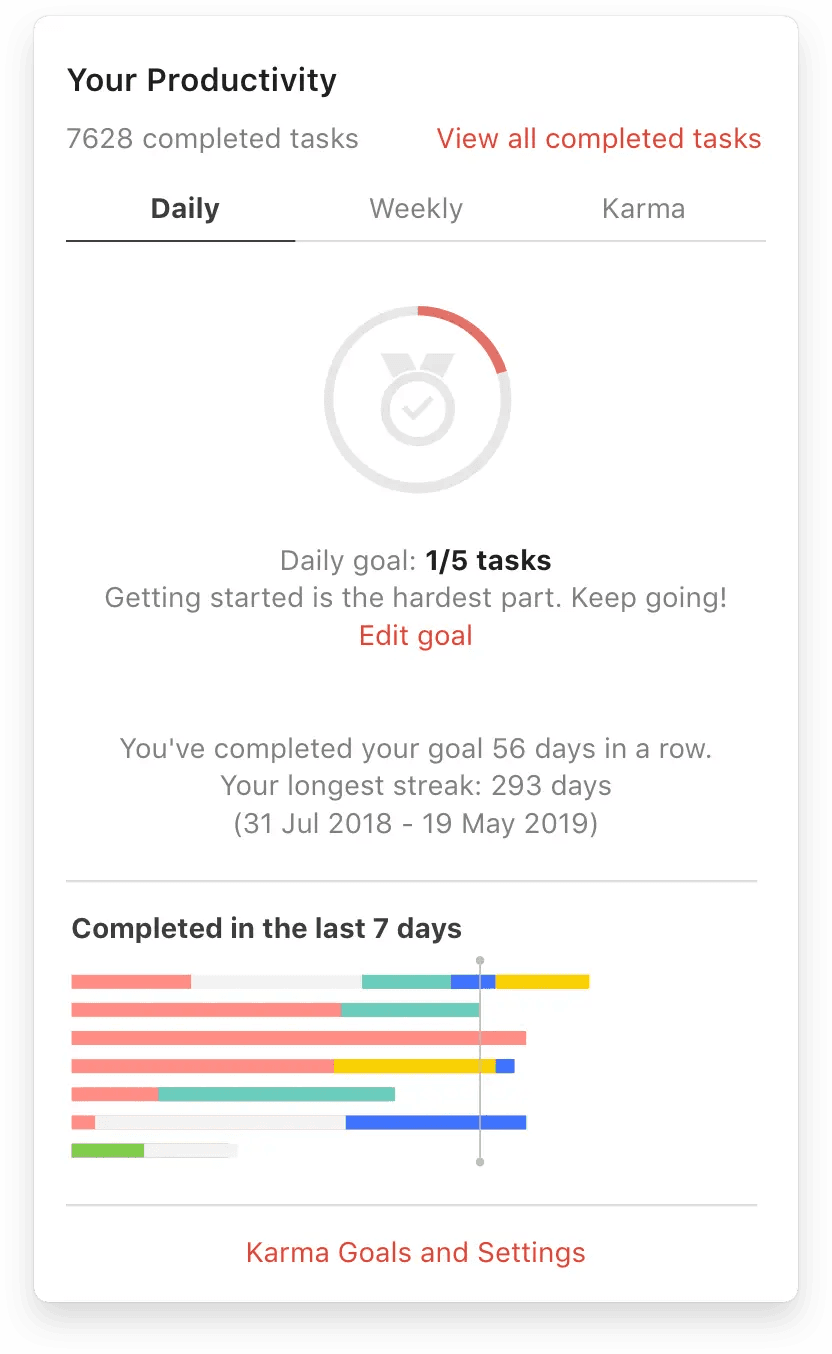
Source: Todoist
To sum up, to-do lists are a great time management tool, but they shouldn’t just be a way for you to put tasks out of your mind.
Use them in a highly organized way and enlist the help of software to build a system that will help you complete your work more efficiently and on time.
Eliminate Distractions
Technical writing requires deep focus. Writers need to thoroughly understand the product they’re describing and provide clear instructions with zero missteps to make their documentation helpful to end-users.
In those circumstances, even the smallest distraction can cause you to lose your momentum, and it can take you ages to get back to your work.
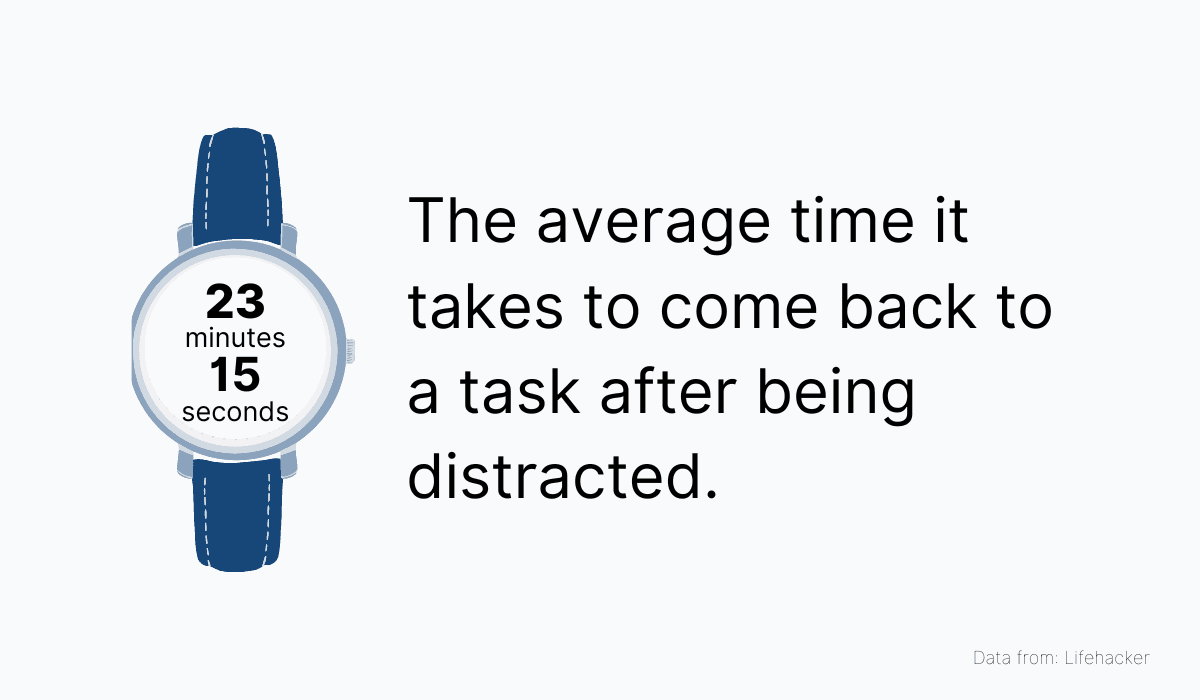
Source: Archbee
Being distracted at work from time to time may not seem like a big deal. However, the problem is that distractions can compound and put entire projects behind schedule.
Have a look at some startling statistics that should make you realize just how bad things can get.
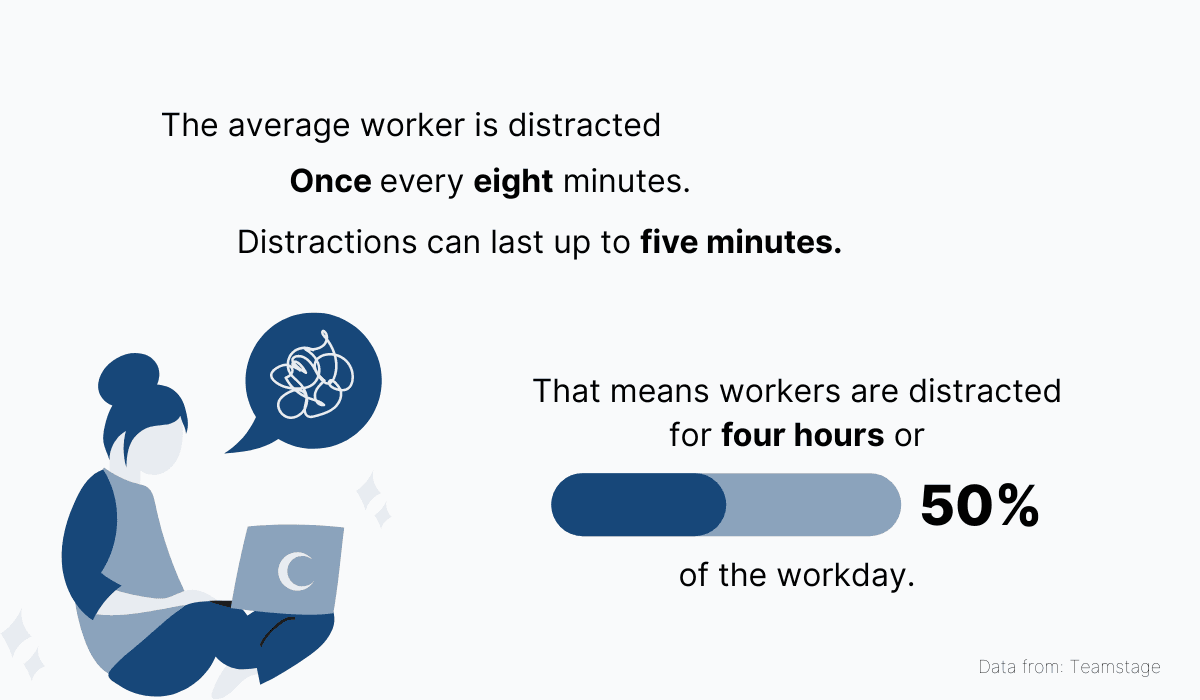
Source: Archbee
In the modern workplace, avoiding distractions completely is an impossible task.
However, there is one thing you could do to minimize them. It might seem counterproductive in terms of effective time management, but here it is.
Stop multitasking and concentrate on just one task at a time.
Like anyone else, you’re probably bombarded with incoming emails, social media notifications, and DMs on your company’s communication app.
You may think each of these messages needs an immediate response, so you don’t realize much time you’re wasting by simultaneously working on documentation and responding to external stimuli.
However, Earl Miller, a neuroscientist from MIT, explains how this impedes you from doing your best work:
“Say you stop writing a pitch for a client in order to check an incoming email—when you finally return to the pitch, your brain has to expend valuable mental energy refocusing on the task, backtracking, and fixing errors. Not only does this waste time, it decreases your ability to be creative.”
The simple solution is to block out time for different types of work. If you’re drafting a document, mute your communication apps.
After you’ve written a satisfactory amount of text, take a couple of minutes to respond to emails and participate in the Slack discussion.
Distractions are a major pitfall for knowledge workers, including technical writers.
If you want to manage your time better and stop losing an entire half of every workday, start avoiding them and focus on the task at hand.
Prioritize Difficult Tasks
As you probably already know, productivity can be a fickle thing.
On the face of it, it might seem logical to start your day with a couple of easier tasks, just to get yourself going, and build up the momentum to tackle more difficult work later.
However, this might not be the best way to go about things.
In fact, it’s a proven fact that getting an early start on more difficult tasks makes sense because we’re more productive earlier in the day.
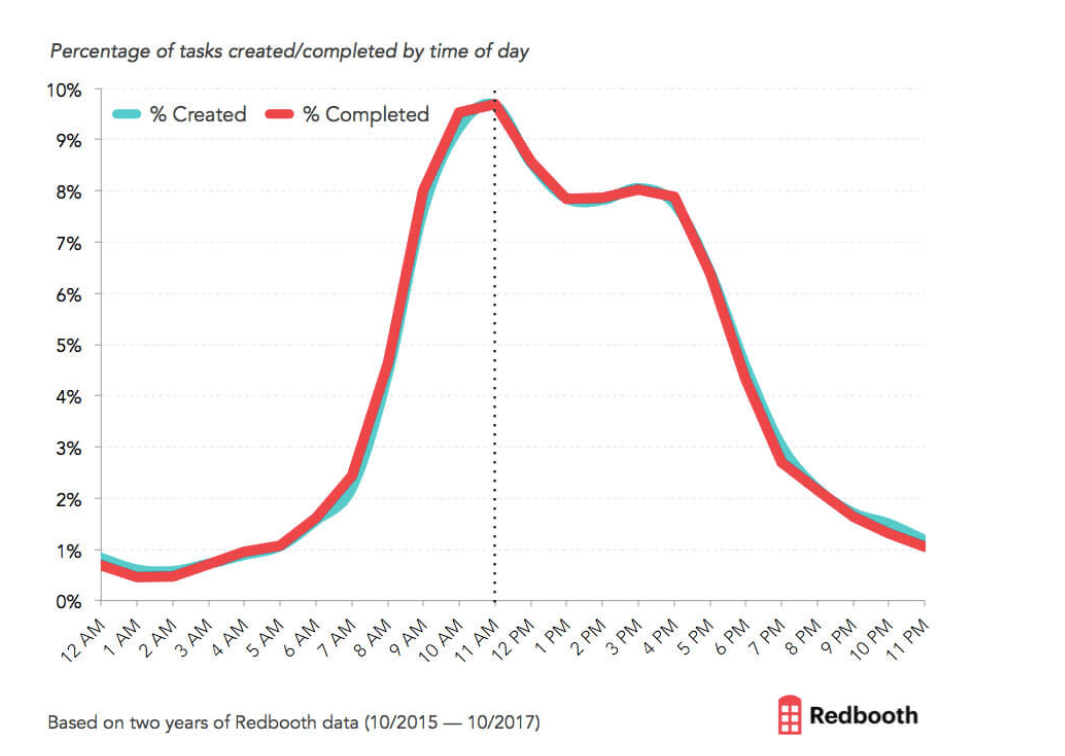
Source: Redbooth
The graph you see above is the result of an analysis of hundreds of thousands of tasks created in Redbooth, a task management tool. It shows us that the greatest amount of tasks is completed by 11 am, after which productivity starts to fall, and finally plummets after about 4 pm.
Logically, this leads us to the conclusion that the more difficult tasks should be prioritized and completed earlier in the day when your productivity is at peak levels.
If they’re left for last, they’ll likely take longer to complete or might even be put off for another time.
Some of the top leaders in the world of business know this and use it to their advantage.
For example, Mark Cuban, the billionaire entrepreneur, likes to deal with the stressful stuff before he even gets out of bed, as he explains in this short interview:
Source: Vanity Fair on YouTube
The most important question, then, is what do you consider your most difficult tasks?
Let’s turn to the experts and examine what real technical writers consider to be the most difficult aspects of their work.
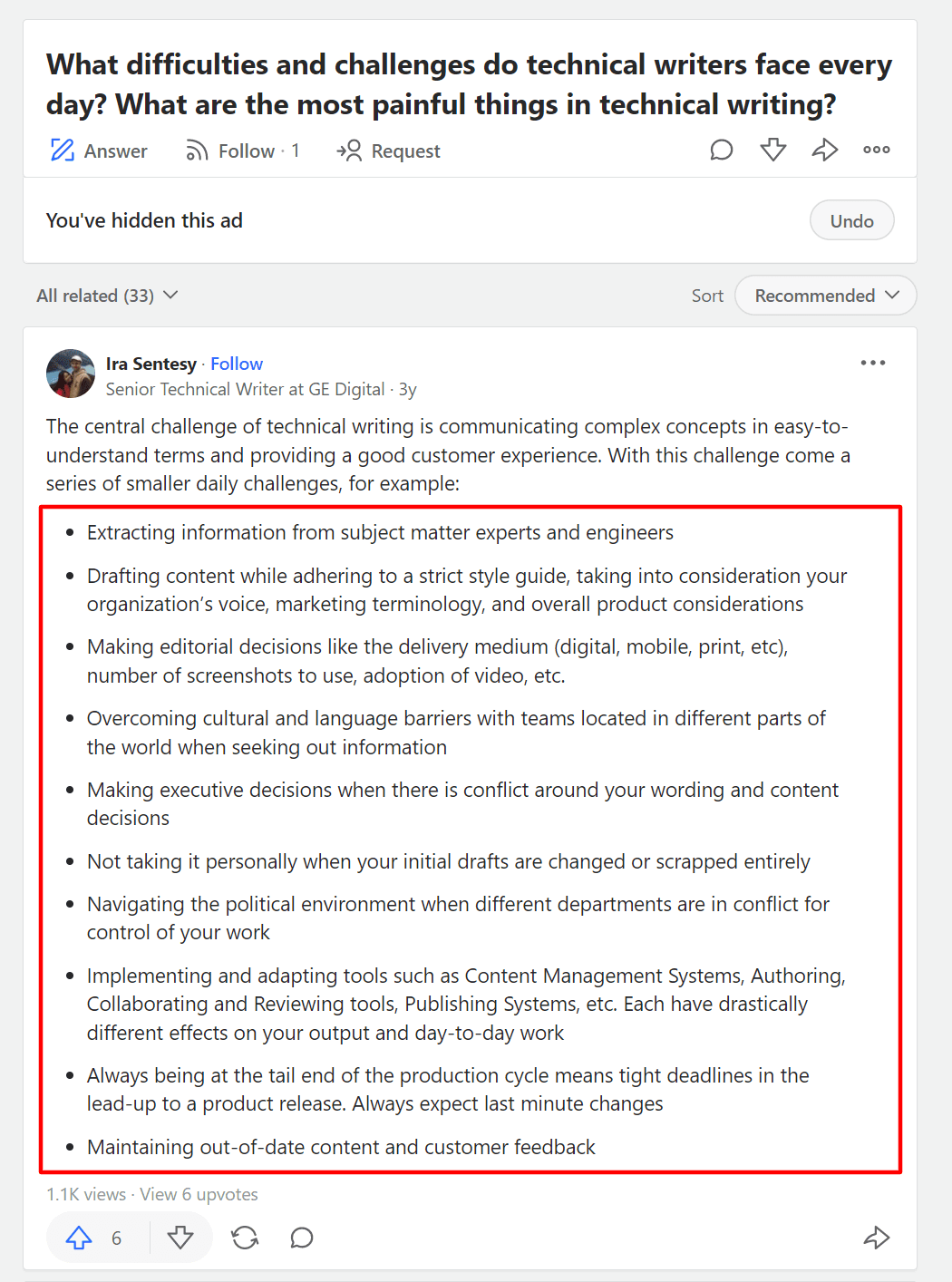
Source: Quora
So, for example, if you know you struggle with getting your SMEs to sit down and talk to you about ongoing projects, it may be a good idea to prioritize that task as soon as it appears on your daily schedule.
All in all, avoiding procrastination and getting things done while you’re at your most productive are both excellent ways to manage your time better.
So try to figure out the tasks you struggle with the most and prioritize them over tasks that are easy to cross off your list.
Take Breaks
Speaking of productivity, it’s extremely important to realize that no one can be productive for eight hours straight.
Trying to keep your focus up for such a prolonged amount of time will necessarily result in fatigue and mistakes made along the way.
In terms of time management, this easily translates into work slowing down.
After a certain point, it will take you more time to complete complex tasks, and you’ll have to go back to fix errors you made because you were too tired to concentrate.
This problem also has an easy solution: you should structure your work to include regular breaks to refresh your mind and combat fatigue.
This claim is supported by many studies done over the years.
One of them, conducted by the Draugiem Group, involved tracking work using a computer application to examine people’s working habits.
It determined that employees who took regular, intentional breaks ended up accomplishing more in a day than those who tried to work continuously throughout the day.
The study concluded that the best practice was to take a seventeen-minute break after 52 minutes of work.
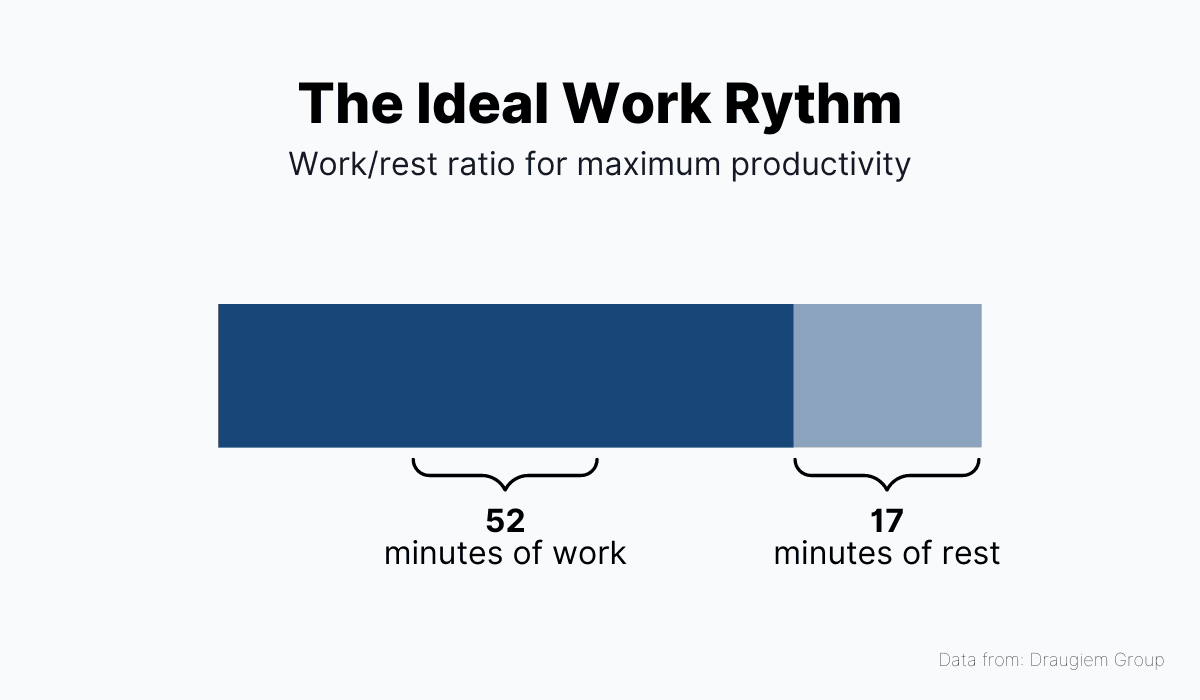
Source: Archbee
Why this exact ratio? Well, the researchers saw that employees who used this rhythm for their work were able to achieve near-perfect focus and productivity for the time they spent working.
Of course, individual differences should be taken into account here, and if this method doesn’t suit you, you could try the Pomodoro Technique.
Remember Amruta Ranade from our section about creating a schedule? That’s the technique she uses when she does her drafting and user testing every morning.
Here’s how it works in a nutshell:
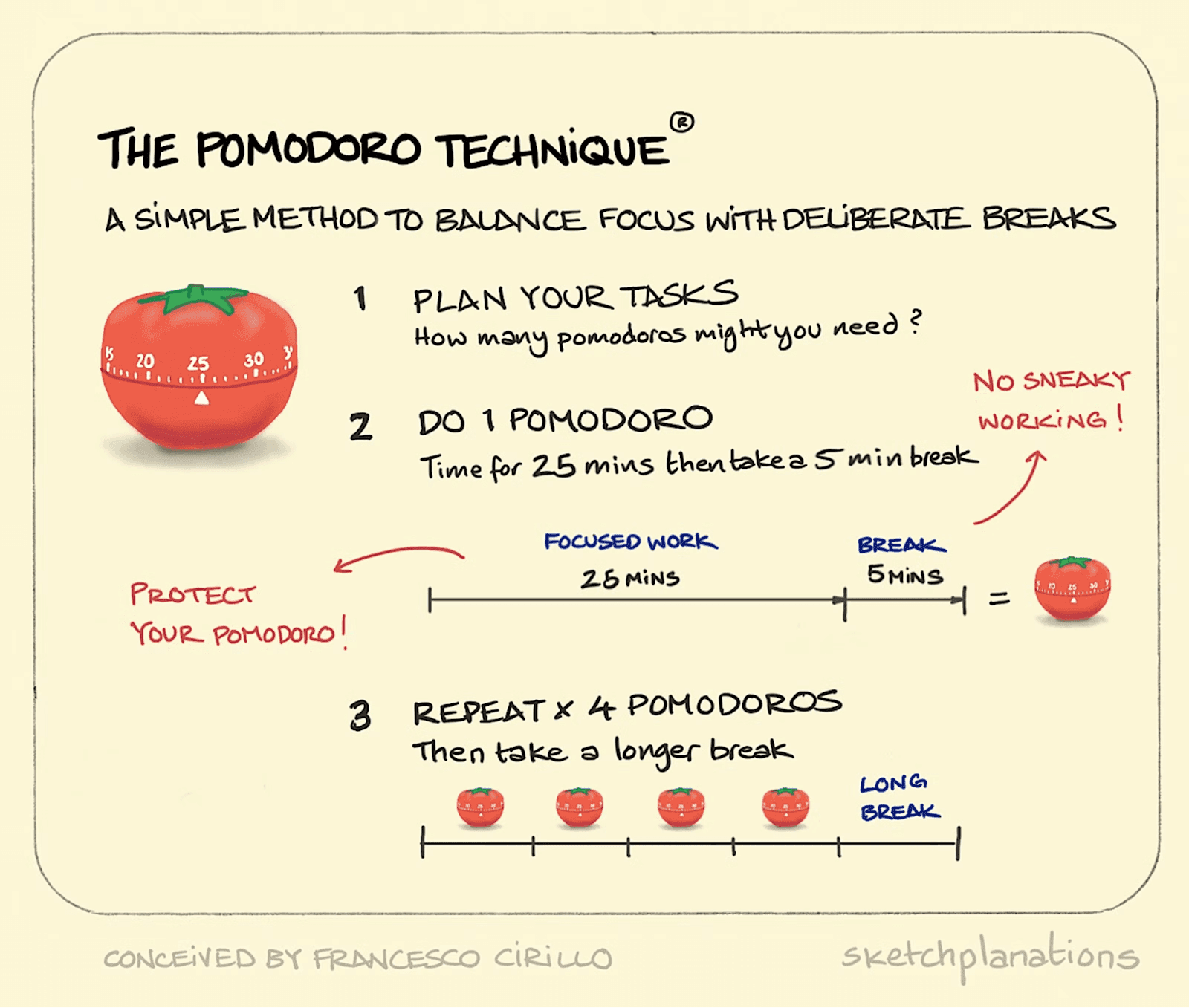
Source: Sketchplanations
This might be a better choice if you find it difficult to focus for an entire hour or don’t need a break as long as 17 minutes to keep your focus.
Whatever your ideal rhythm is, don’t forget to disconnect from work completely.
Don’t do a different type of work, don’t talk about work, and get away from your screens (computer and phone) for a bit.
Another technical writing expert, Kesi Parker, recommends standing up and moving around:
“Usually, I use notifications that remind me to stand up, even if I’m very busy and don’t feel tiredness, I don’t miss my breaks. The best way to spend your free time is to walk outdoors.”
With your mind alert and your concentration levels high, you’ll be surprised at how much work you can get done without working yourself to the bone. So don’t forget to take regular breaks.
Use the Right Tools
If you're noticing you can’t keep up with your work and are having problems with time management, it might be time to look into how your work can be improved with software.
Firstly, if your technical writing process involves a lot of meetings with engineers, managers, and other SMEs, it might be a good idea to try out a meeting app, such as Hypercontext.
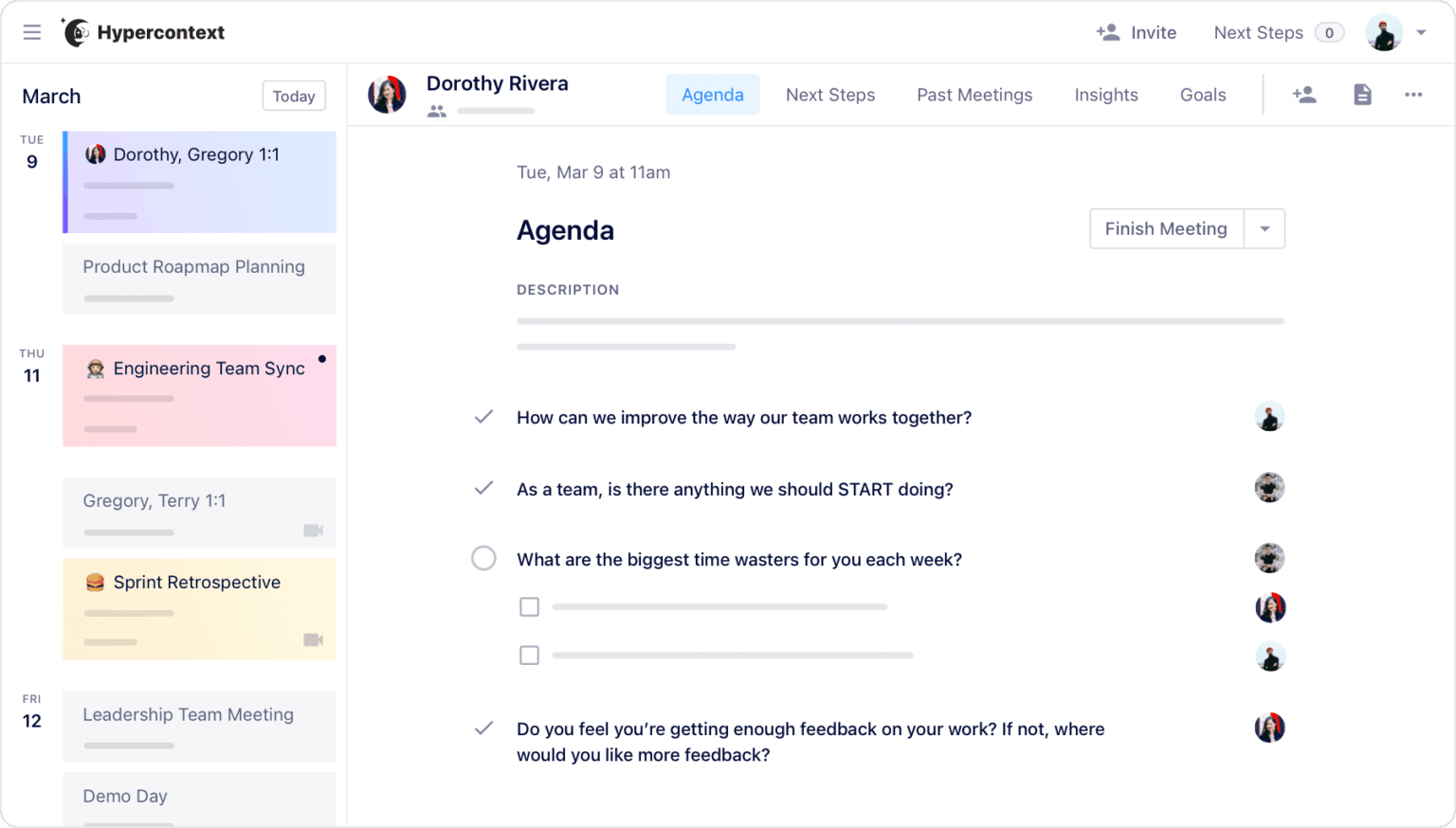
Source: Hypercontext
This tool will enable you to easily set up meetings, share your agenda, and establish goals for your collaboration with SMEs.
That way, you should have a much easier time sitting down with your experts and getting the answers you need to create quality documentation.
Moving on, the one tool no technical writer should do without is your documentation software.
Modern documentation software will allow you to draft documentation using plain text, diagrams, multimedia, and even code as easily as writing a plain Word or Google document.
For example, Archbee has more than thirty custom blocks that will enable you to express yourself in every way you need to adequately transfer knowledge to your end-users.
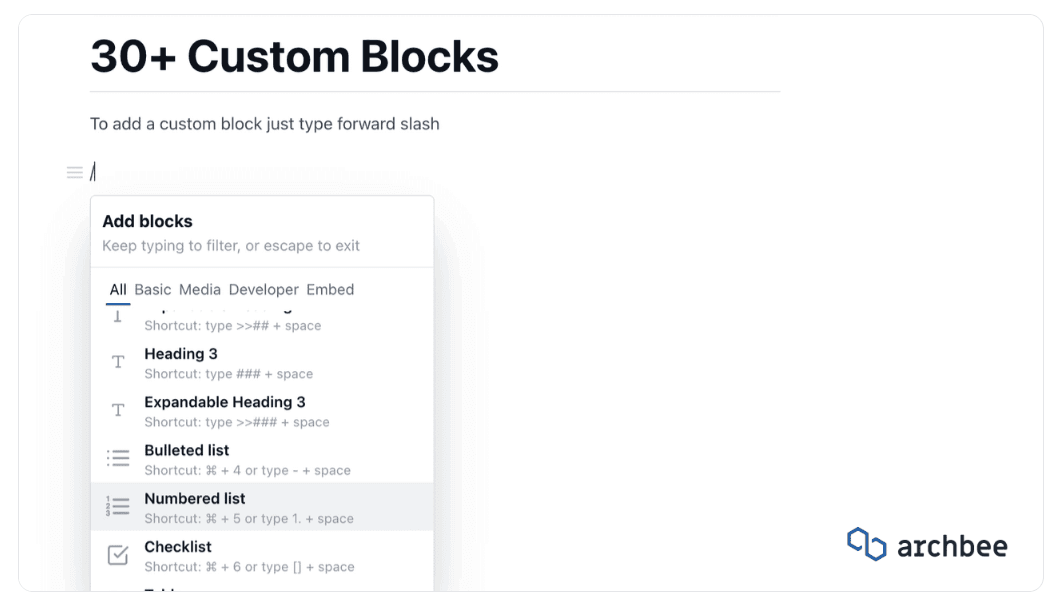
Source: Archbee
The best available software, Archbee included, has a number of other functions.
These include collaboration features that enable you and your colleagues to work on documentation as a team, one-click publishing capabilities so you can upload your documents to your domain in a flash and without any programming knowledge, and document verification options that will help you maintain your docs and keep them up to date.
Source: Archbee on Youtube
Finally, you can speed up your editing process by employing tools such as Grammarly.
They will help you seek out and correct errors in your writing, as well as ensure that your documents are clear, engaging, and on-brand.

Source: Engadget
There’s a software tool for every possible technical writing task these days.
If you want to work faster, more efficiently, and with increased accuracy, don’t hesitate to rely on these invaluable tools.
Conclusion
We hope this article has successfully proven to you that better time management is achievable.
Even the biggest obstacles standing in the way of optimal productivity often have incredibly simple solutions.
All you have to do is nurture some good habits and structure your work in a way that will enable you to achieve your goals without risking burnout.
Frequently Asked Questions
Start with a weekly plan mapped to document phases, then time-block your calendar. Protect your most focused hours for drafting, testing, and complex edits; batch meetings and SME chats in the afternoon. Use a prioritized to-do system that includes deadlines, effort estimates, and dependencies (a tool like Todoist helps). Single-task—mute notifications and check email/Slack in scheduled batches. Tackle the hardest item first when energy is highest. Work in sprints with planned breaks (Pomodoro or the 52/17 rhythm). Review progress daily and adjust. Lean on the right tools: documentation platform (e.g., Archbee), meeting/agenda apps (e.g., Hypercontext), and quality checkers (e.g., Grammarly). Create templates and checklists, and renegotiate scope or timelines early when needed.



